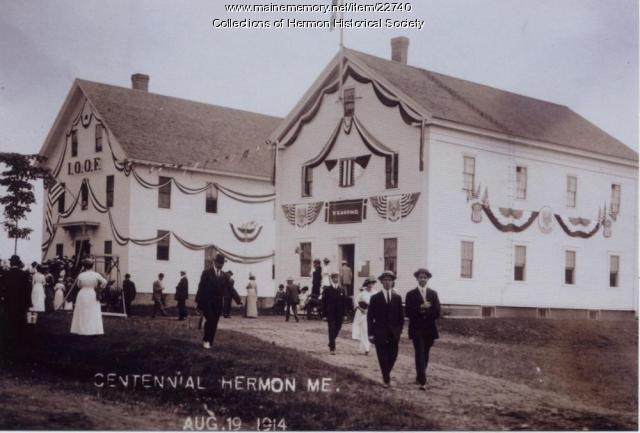Keywords: historic architecture
Item 4007
Eastern Maine Insane Hospital, Bangor, 1896
Contributed by: Maine Historical Society Date: 1896 Location: Bangor Media: Architectural drawing
Item 6030
House sketch, Cushing Island, ca. 1883
Contributed by: Maine Historical Society Date: circa 1883 Location: Portland Media: Architectural drawing
Item 151384
Maine Historical Society, Portland, ca. 2015
Contributed by: Maine Historical Society Date: circa 2015 Location: Portland Client: Maine Historical Society Architect: Carol A. Wilson; Carol A. Wilson Architect
Item 151369
Chebeague Island Historical Society, Chebeague Island, 2001
Contributed by: Maine Historical Society Date: 2001 Location: Chebeague Island Client: Chebeague Island Historical Society Architect: Carol A. Wilson; UJMN and Carol A. Wilson Architects
Exhibit
The Barns of the St. John River Valley: Maine's Crowning Jewels
Maine's St. John River Valley boasts a unique architectural landscape. A number of historical factors led to the proliferation of a local architectural style, the Madawaska twin barn, as well as a number of building techniques rarely seen elsewhere. Today, these are in danger of being lost to time.
Exhibit
MHS in Pictures: exploring our first 200 years
Two years after separating from Massachusetts, Maine leaders—many who were part of the push for statehood—also separated from Massachusetts Historical Society, creating the Maine Historical Society in 1822. The legislation signed on February 5, 1822 positioned MHS as the third-oldest state dedicated historical organization in the nation. The exhibition features MHS's five locations over the institution's two centuries, alongside images of leaders who have steered the organization through pivotal times.
Site Page
Architecture & Landscape database - Maine Architectural Renderings
"… Historical Society With the emergence of the architectural profession in Maine in the mid-nineteenth century, architects provided renderings to…"
Site Page
Architecture & Landscape database - Database Overview
"… and designed environment, this database includes architecture and landscape design commissions from ca. 1850 through the present."
Story
Biddeford City Hall: an in-depth tour of this iconic building
by Biddeford Cultural & Heritage Center Voices of Biddeford project
Visual tour and unique insights of Biddeford’s historical landmark
Story
Tammy Ackerman: Falling in love with Biddeford
by Biddeford Cultural & Heritage Center
Someone "from away" who fell in love with Biddeford and contributed to its transformation
Lesson Plan
Building Community/Community Buildings
Grade Level: 6-8
Content Area: Social Studies
Where do people gather? What defines a community? What buildings allow people to congregate to celebrate, learn, debate, vote, and take part in all manner of community activities? Students will evaluate images and primary documents from throughout Maine’s history, and look at some of Maine’s earliest gathering spaces and organizations, and how many communities established themselves around certain types of buildings. Students will make connections between the community buildings of the past and the ways we express identity and create communities today.
Lesson Plan
Longfellow Studies: "The Jewish Cemetery at Newport"
Grade Level: 6-8, 9-12
Content Area: English Language Arts, Social Studies
Longfellow's poem "The Jewish Cemetery at Newport" opens up the issue of the earliest history of the Jews in America, and the significant roles they played as businessmen and later benefactors to the greater community. The history of the building itself is notable in terms of early American architecture, its having been designed, apparently gratis, by the most noted architect of the day. Furthermore, the poem traces the history of Newport as kind of a microcosm of New England commercial cities before the industrialization boom. For almost any age student the poem could be used to open up interest in local cemeteries, which are almost always a wealth of curiousities and history. Longfellow and his friends enjoyed exploring cemeteries, and today our little local cemeteries can be used to teach little local histories and parts of the big picture as well.
Henry Wadsworth Longfellow visited the Jewish cemetery in Newport, RI on July 9, 1852. His popular poem about the site, published two years later, was certainly a sympathetic portrayal of the place and its people. In addition to Victorian romantic musings about the "Hebrews in their graves," Longfellow includes in this poem references to the historic persecution of the Jews, as well as very specific references to their religious practices.
Since the cemetery and the nearby synagogue were restored and protected with an infusion of funding just a couple years after Longfellow's visit, and later a congregation again assembled, his gloomy predictions about the place proved false (never mind the conclusion of the poem, "And the dead nations never rise again!"). Nevertheless, it is a fascinating poem, and an interesting window into the history of the nation's oldest extant synagogue.

















